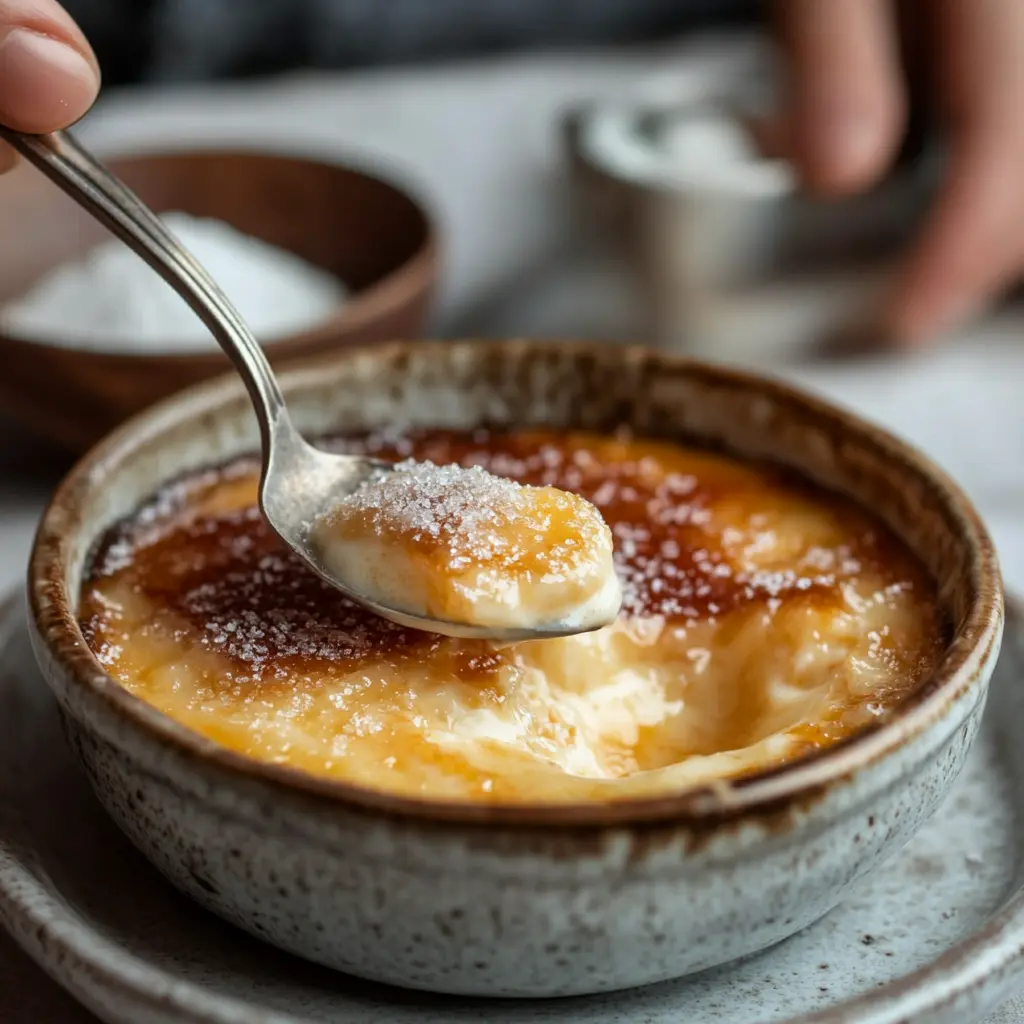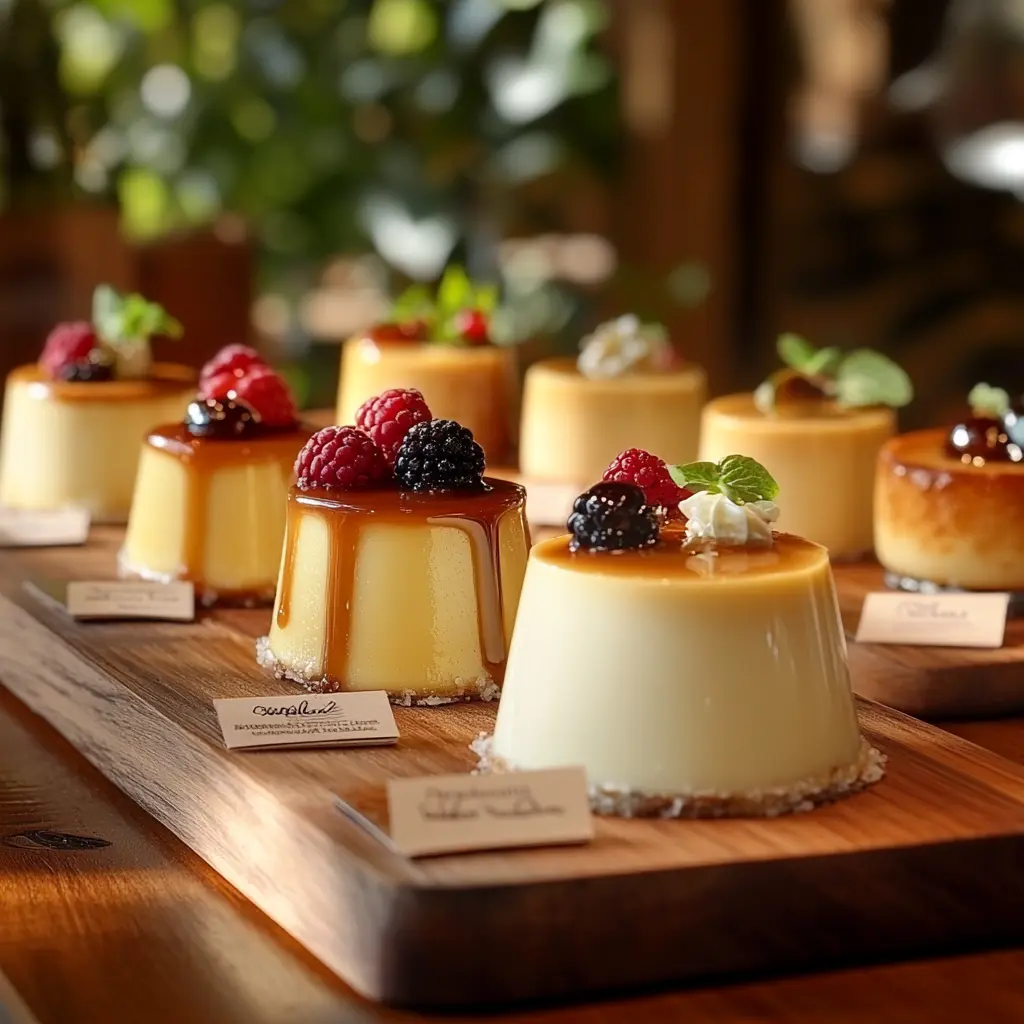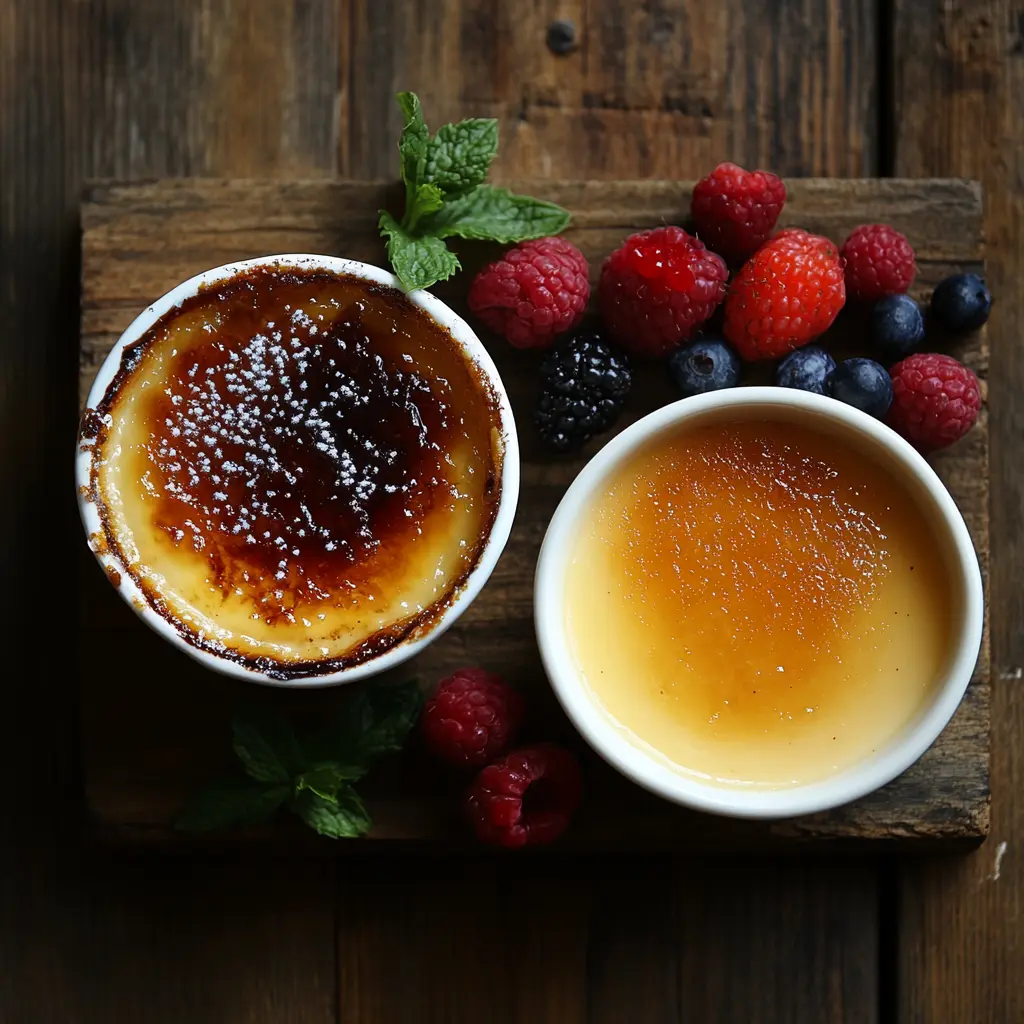Introduction
When it comes to classic desserts, few can rival the charm of crème brûlée or the timeless appeal of custard. Though they may look similar, their differences are striking when you dig deeper. From unique cooking techniques to distinctive textures, these two desserts cater to diverse tastes. This article explores their fascinating origins, ingredients, and the nuanced art behind crafting each treat.
Let’s dive into the details and uncover what’s the difference between crème brûlée and custard in terms of flavor, history, and preparation.
Part 1: Understanding Custard
Definition and History
Custard is a versatile culinary marvel that has found its way into countless dishes across the globe. At its core, custard is a mixture of milk or cream, egg yolks, and sugar, gently heated to achieve a thickened, creamy consistency. This dessert traces its roots back to the Middle Ages, where it was commonly used as a filling for pies and tarts. Its rich texture made it a favorite among royalty and commoners alike.
The beauty of custard lies in its adaptability. Whether it’s baked, stirred, or frozen, this dessert has an uncanny ability to pair with everything from fruits to pastries.
Types of Custard: Baked vs. Stirred
Custard primarily comes in two forms: baked and stirred. Baked custard is cooked slowly in an oven, often using a water bath to ensure a smooth texture. It’s firm and sliceable, making it ideal for desserts like crème caramel or quiche.
On the other hand, stirred custard, also known as crème anglaise, is cooked over a stovetop. Its creamy, pourable consistency is perfect for drizzling over cakes or using as a base for ice cream. Each type of custard brings its own unique charm to the table.
Common Ingredients and Preparation Methods
Creating custard is as much about precision as it is about flavor. The main ingredients—milk, cream, egg yolks, and sugar—work together in perfect harmony. Often, a pinch of vanilla or other flavorings is added to elevate the taste.
The process requires a careful balance of heat and timing. Heating the mixture too quickly can lead to curdling, while undercooking might leave it runny. Whisking consistently and monitoring the temperature are crucial to achieving that silky-smooth finish.
In many households, custard serves as a comforting dessert, simple yet deeply satisfying. Whether served warm or chilled, it’s the epitome of elegance in simplicity.
Part 2: Exploring Crème Brûlée
Definition and Origins
Crème brûlée, often dubbed the crown jewel of French desserts, is a custard-based delight topped with a caramelized sugar crust. Its name translates to “burnt cream” in French, a nod to its signature crackling topping achieved through torching. Despite its French association, the origins of crème brûlée are debated, with some attributing its creation to the English or Spanish. Regardless, it has become a staple in fine dining and casual kitchens alike.

Traditional Ingredients
The classic recipe for crème brûlée shares similarities with custard, primarily using heavy cream, egg yolks, sugar, and vanilla. What sets it apart is the focus on richness, with heavy cream taking center stage to create a thicker, creamier texture.
The topping, made from a thin layer of sugar, is caramelized to perfection, providing a delightful contrast of textures—crunchy on top and creamy underneath.
Preparation Techniques
Making crème brûlée is an art that requires patience and precision. After the custard base is prepared, it’s poured into shallow ramekins and baked in a water bath to ensure even cooking. The dessert is then chilled to set its custard base.
The pièce de résistance comes just before serving: sprinkling sugar over the set custard and caramelizing it with a culinary torch or under a broiler. The result is a glass-like crust that cracks delightfully with a spoon, unveiling the velvety custard beneath.
Whether enjoyed at an elegant dinner or as a comforting treat, crème brûlée’s blend of textures and flavors makes it truly unforgettable.
Part 3: Key Differences Between Crème Brûlée and Custard
Ingredients and Proportions
While both crème brûlée and custard share similar foundational ingredients—cream, eggs, sugar, and vanilla—the proportions differ significantly. Crème brûlée leans heavily on cream, creating a richer and thicker consistency. Custard, in contrast, often balances milk and cream or may even use milk alone for a lighter texture.
The sugar content in crème brûlée is also critical, as it not only sweetens the custard but creates the iconic caramelized crust. Custard’s sweetness varies depending on its intended use, ranging from mildly sweet to intensely rich in desserts.
Cooking Methods
One of the most striking differences lies in their preparation. Crème brûlée is always baked in shallow dishes, using a bain-marie or water bath to gently cook the custard. After cooling, it’s topped with sugar that’s caramelized into a glassy crust. This finishing touch is what sets crème brûlée apart.
Custard, on the other hand, boasts a more diverse range of cooking techniques. It can be baked, stirred on a stovetop, or even steamed, depending on the desired consistency and use. Baked custard solidifies into a firm texture, while stirred custard remains creamy and fluid.
Texture and Consistency
Texture is where these desserts truly diverge. Crème brûlée is known for its luxurious, almost pudding-like custard base beneath a brittle caramelized topping. Its creamy richness melts in your mouth while offering the delightful contrast of crunch from the sugar crust.
Custard’s texture, however, depends on its preparation. Baked custards like flan are firm enough to hold their shape, while stirred custards such as crème anglaise are velvety and pourable. The versatility of custard makes it adaptable for both standalone desserts and complementary sauces.
Flavor Profiles
Though vanilla is a staple flavor for both, crème brûlée often carries a distinct richness due to the heavy cream. The caramelized topping adds a subtle bitterness that beautifully offsets the sweetness of the custard.
Custard, however, is a blank canvas, lending itself to endless variations. It can be flavored with citrus, chocolate, spices, or even fruits. This adaptability makes custard a favorite for creative chefs and home cooks alike.
Crème brûlée dazzles with its refined simplicity, while custard impresses with its versatility, proving that there’s a dessert for every occasion.
Part 4: Variations and Similar Desserts
Crème Caramel
Often confused with crème brûlée, crème caramel is a custard dessert with a distinct personality. Unlike the crunchy sugar topping of crème brûlée, crème caramel features a liquid caramel layer that forms during baking. The custard is inverted onto a plate before serving, showcasing its glossy caramel sauce. It’s lighter in texture and typically uses more milk than cream, making it less rich but equally satisfying.

Pot de Crème
Pot de crème, another custard-based delight, translates to “pot of cream” in French. It’s typically richer than custard due to its high cream content, much like crème brûlée. Served in small pots or jars, it’s not caramelized but is instead enjoyed as a thick, spoonable dessert, often enhanced with chocolate or coffee flavors.
Flan
Flan shares similarities with crème caramel, boasting a soft custard base with a caramel topping. However, flan is more commonly associated with Spanish and Latin American cuisine, often infused with regional ingredients like condensed milk or coconut. Its creamy texture and sweet caramel make it a beloved treat worldwide.
Other Regional Variations
Around the globe, custard-based desserts take on unique forms. In Italy, zabaglione is a light, whipped custard often flavored with marsala wine. In Asia, steamed egg custards can be sweet or savory, showcasing the diversity of custard applications.
These variations highlight the versatility of custard and its ability to be reinvented across cultures, from the elegantly simple to the richly indulgent.
Conclusion of the Section
Exploring these desserts showcases just how nuanced the custard family can be. Whether it’s the decadent richness of crème brûlée or the delicate sweetness of flan, there’s a custard dessert for every palate.
Part 5: Serving Suggestions and Pairings
Ideal Serving Temperatures
When it comes to enjoying crème brûlée and custard, temperature plays a pivotal role in enhancing flavor and texture. Crème brûlée is best served chilled to create a refreshing contrast between its creamy base and the brittle caramelized topping. The cool custard complements the slightly warm, crisp sugar layer, creating a delightful sensory experience.
Custard’s serving temperature depends on its preparation. Stirred custards like crème anglaise are often served warm as a sauce, while baked custards, such as flan, are typically enjoyed chilled or at room temperature. For frozen custards, a soft, creamy texture is preferred, making them a popular summertime treat.
Garnishes and Accompaniments
Adding garnishes can elevate both the flavor and presentation of these desserts. For crème brûlée, a sprinkle of fresh berries, a sprig of mint, or a dusting of powdered sugar can provide visual appeal and a burst of complementary flavors. Custard, depending on its type, pairs wonderfully with seasonal fruits, whipped cream, or even a drizzle of chocolate sauce.
To balance the richness of both desserts, consider serving them with something light, such as a crisp biscotti or a plain shortbread cookie. The contrast in textures creates an exciting interplay on the palate.
Beverage Pairings
Though traditional pairings like wine are often suggested, non-alcoholic options can work just as beautifully. For crème brûlée, a hot cup of coffee or a delicate herbal tea enhances its richness without overpowering it. Custard desserts pair well with a creamy chai latte or a refreshing fruit juice, depending on their flavors.
These thoughtful serving suggestions ensure that every spoonful of crème brûlée or custard becomes an indulgent experience to savor.
Part 6: Nutritional Comparison
Caloric Content
Crème brûlée, with its heavy cream and caramelized sugar topping, is undeniably richer in calories compared to custard. A standard serving can contain upwards of 250–300 calories, largely due to the generous cream and sugar proportions.
Custard, particularly when made with milk instead of cream, tends to be lighter. A typical serving might range from 150–200 calories, making it a slightly more forgiving option for those watching their intake.
Macronutrient Breakdown
Crème brûlée is high in fat, largely from the cream and egg yolks, which contribute to its luxurious texture. Custard, while also containing fats, may have a higher protein-to-fat ratio depending on its preparation, especially if milk is used as the base.
Sugar content varies for both, but crème brûlée typically has more due to its caramelized topping. Custards like flan or crème caramel, which rely on liquid caramel, may contain less overall sugar.
Dietary Considerations
For those with dietary restrictions, custard is more adaptable. It can be modified with plant-based milk or sugar substitutes for a dairy-free or low-sugar alternative. Crème brûlée, due to its reliance on heavy cream, is less accommodating but can still be adjusted with creativity and experimentation.
Understanding these nutritional differences allows dessert lovers to make informed choices while still indulging in their favorite sweet treats.
Part 7: Popularity and Cultural Significance
Crème Brûlée in French Cuisine
Crème brûlée is synonymous with French elegance, often regarded as the quintessential dessert in fine dining. Its iconic caramelized sugar crust is not just a visual treat but also a testament to culinary artistry. Many attribute its enduring popularity to the blend of simplicity in ingredients and sophistication in presentation.
Though deeply rooted in France, crème brûlée has gained global acclaim, appearing on menus worldwide. Its preparation has become a rite of passage for aspiring chefs, showcasing their precision and technique.
Custard in Various Cultures
Custard enjoys a more widespread and adaptable legacy. Across Europe, it features prominently in dishes like British custard tarts or Italian zabaglione. In Asia, custards take on diverse forms, from the silky smooth egg tarts of Hong Kong to the savory steamed varieties found in Japan.
Latin America celebrates custard through flan, a dessert deeply ingrained in its culinary traditions. Its caramelized sweetness resonates with generations, making it a cherished family favorite.
Modern Interpretations and Trends
In today’s culinary landscape, both crème brûlée and custard have seen innovative twists. Pastry chefs experiment with flavors like lavender, matcha, or coconut in crème brûlée, adding a contemporary flair. Custard, too, adapts with vegan versions or being infused into trendy desserts like doughnuts or croissants.
The versatility of custard and the sophistication of crème brûlée continue to captivate dessert enthusiasts, ensuring their place in kitchens and on menus worldwide.
Part 8: Common Misconceptions
Crème Brûlée as Just a Fancy Custard
A common myth is that crème brûlée is simply custard in a fancier form. While it does belong to the custard family, its unique preparation and presentation elevate it to a class of its own. The caramelized sugar topping, achieved through torching, is a defining feature that no other custard-based dessert replicates.
Interchangeability in Recipes
Many believe that custard and crème brûlée can be substituted in recipes. However, their differing textures and cooking methods make them ill-suited for direct swaps. Custard’s versatility allows it to adapt to savory dishes, while crème brûlée’s richness and caramel topping confine it to sweet treats.
Health Implications
Another misconception is that custard is always the healthier option. While custard can be lighter when made with milk, some variations, like flan or crème caramel, can have comparable calorie and sugar content to crème brûlée. Understanding ingredient choices helps dispel this myth and guides healthier decisions.
Recognizing these misconceptions ensures a deeper appreciation for the art and science behind these beloved desserts.
Part 9: Tips for Home Cooks
Choosing the Right Ingredients
The secret to crafting the perfect crème brûlée or custard lies in selecting high-quality ingredients. Opt for fresh eggs, full-fat cream or milk, and pure vanilla extract. For crème brûlée, heavy cream is non-negotiable to achieve its signature richness. Meanwhile, custard allows more flexibility, making it possible to substitute with low-fat milk or plant-based alternatives without compromising too much on texture.
Equipment Essentials
A few key tools can make all the difference in your dessert-making journey. For crème brûlée, shallow ramekins are ideal, ensuring an even caramelized crust and perfect custard-to-crust ratio. A culinary torch is essential for achieving that crackling sugar topping, though a broiler can work in a pinch.
For custard, a heatproof mixing bowl, a whisk, and a thermometer are invaluable. Using a thermometer prevents overheating and curdling, ensuring silky-smooth results. A fine mesh strainer is also a lifesaver for removing lumps or overcooked egg bits from the custard base.
Troubleshooting Common Issues
Even experienced cooks encounter challenges when making these desserts. For crème brûlée, uneven sugar caramelization can be avoided by sprinkling a thin, even layer of sugar and torching it slowly.
Custards, on the other hand, often risk curdling if overheated. To prevent this, use gentle heat and stir continuously for stirred custards or bake in a water bath for baked versions. If the custard turns grainy, blending it gently or passing it through a fine sieve can help salvage the texture.
By mastering these tips, home cooks can confidently recreate the magic of crème brûlée and custard, impressing family and guests alike.
Part 10: Frequently Asked Questions (FAQs)
Is Crème Brûlée a Type of Custard?
Yes, crème brûlée is a type of baked custard, distinguished by its caramelized sugar topping. Its base ingredients are similar to traditional custard, but its preparation and final presentation set it apart.
Can I Make Crème Brûlée Without a Torch?
Absolutely! While a culinary torch is the preferred method, you can achieve the caramelized topping by placing the ramekins under a broiler for a few minutes. Keep a close eye to prevent burning.
What’s the Difference Between Crème Brûlée and Flan?
Crème brûlée has a crunchy caramelized sugar topping, while flan features a liquid caramel sauce. Additionally, flan is typically lighter and uses a higher proportion of milk.
How Do I Prevent Custard from Curdling?
Curdling occurs when the eggs overheat. To avoid this, cook custard gently over low heat or bake it in a water bath. Using a thermometer to monitor the temperature can also be helpful.
Can a dairy-free version of custard be made?
Yes! Substituting milk with almond, coconut, or oat milk and using plant-based cream can create delicious dairy-free custards. Adjust the flavorings to complement the chosen milk.
How Long Does Crème Brûlée Last in the Fridge?
You can store crème brûlée in the fridge for up to three days. However, it’s best to caramelize the sugar topping just before serving to maintain its signature crunch.
Conclusion
Crème brûlée and custard, though similar in their essence, showcase unique characteristics that cater to varied tastes and occasions. Dessert lovers worldwide adore these treats, whether they savor the luxurious crack of crème brûlée’s caramelized crust or enjoy custard’s versatility in countless dishes. Understanding their differences not only enhances your appreciation but also inspires creativity in the kitchen.

